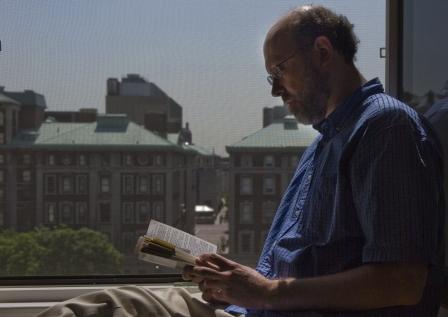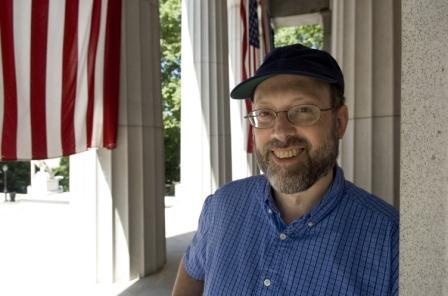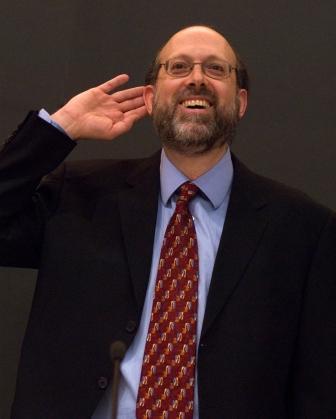Hamburger's Research Highlights First Amendment Erosions
By Adam Liptak
Professor Philip Hamburger says his decision to move to Columbia from the University of Chicago was not hard. He had been hanging around New York on a leave of absence, and there was something about the city that spoke to him – its food.
“I called myself ‘visiting professor at Zabar’s,’” he says. Reflecting on the difference between the two cities, he adds: “You could just say that I was moving from deep dish to thin crust.”
Columbia Law School, of course, invited Hamburger to New York to do more than enjoy the abundance of varied cuisine. His 2002 book on the separation of church and state had cemented his reputation as one of the nation’s leading legal historians and constitutional scholars, and his current work on the constitutionality of institutional review boards (IRBs) is an important area of law rarely probed by scholars.
IRBs, which review and monitor biomedical and behavioral research involving human subjects, were established in the 1970s in response to abusive physiological studies, epitomized by the Tuskegee Syphilis Study conducted on poor – and mostly illiterate – black men in Alabama from 1932-72. Since that time, however, IRBs have expanded their reach into reviewing social science projects. In his 2004 Supreme Court Review article, “The New Censorship: Institutional Review Boards,” Hamburger argues that this expanded review endangers First Amendment rights. Professors and other researchers, he shows, now must get permission from an IRB whether they want to conduct a dangerous physiological experiment or want to ask people about their political opinions. This violates the core First Amendment principle forbidding the licensing of inquiry and speech, Hamburger says.
“It’s really shut down research,” says the Maurice and Hilda Friedman Professor of Law. “If you look at the study of education in the public schools, it’s diminished greatly. The study of sexuality has been profoundly affected.”
Aggravating the problem further, he says, is that the U.S. Supreme Court doctrines on federal spending have undermined the First Amendment guarantee against licensing.
The topic is the subject of presentations he delivers at conferences, and it has evoked strong feelings, as did his book Separation of Church and State (Harvard University Press, 2002). But Hamburger remains affable, engaged, curious – and seemingly wholly unperturbed by controversy.
He was reluctant to talk about himself, and he used a novel technique for putting remarks off the record, good-naturedly covering a reporter’s tape recorder with his blue baseball cap when he was about to say something he did not want in print. A few details emerged nonetheless. He was born far from the world’s great pizza capitals, in London. The Hamburgers ended up in New Haven, Conn., where his father, Joseph, was a distinguished professor of political theory at Yale until his death in 1997. Hamburger’s twin brother, Jeffrey, is an art historian, and not long ago, “we celebrated our 100th birthday,” says the Columbia professor.
After graduating from Princeton and Yale Law School, Hamburger worked at a Philadelphia law firm, first as a litigator and then as a business lawyer – “it seemed more my style to be fixing things than to be making the most of breaking things” – before ending up “for reasons I still don’t quite understand” as a tax lawyer.
All along, though, he was working on original legal articles.
“Already in law school, I was writing articles, which is why I didn’t want to be on law review,” he says.
Just after he graduated from Yale in 1982, the American Journal of Legal History published his account of the history of the statute of frauds.
“It s a subject that most people find exquisitely tedious,” Hamburger says. “The statute of frauds we’re familiar with has these oddly formalistic requirements for contracts and wills and trusts. What I wanted to understand was why all these things were clustered in one statute. The insight came to me, actually, in the first year of contracts class. It suddenly occurred to me that this is connected to all sorts of 17th century pamphlets on the registration of land titles. In fact, the statute of frauds was designed by Sir Matthew Hale, one of the greatest of the 17th century judges, to allow voluntary recording of deeds. It creates a series of incentives for individuals to reduce various kinds of transactions – whether wills or contracts or trusts – to writing, particularly where property was involved, and thereby the voluntary recording of deeds. This was an alternative to something that worried lawyers and the gentry, which was the required recording of deeds or even registration of titles, which was seen as a political threat.”
Another of Hamburger’s early articles considered seditious libel and the freedom of the press in the 17th century and was published in the Stanford Law Review in 1985. Exploring the tension between pre-publication licensing and post-publication punishment, a lively question in constitutional law to this day, informs his work on IRBs. As with his research on religious freedom, some of Hamburger’s colleagues simultaneously admire it and yet think he may go too far too fast in his criticism.
“It’s extremely important work because it calls attention from both the academy and in the wider world to how these committees have morphed into the regulation of inquiry,” saysHarold Edgar ’67, the Julius Silver Professor in Law, Science, and Technology. “This really is the licensing of speech, the licensing of inquiry, in a way that raises questions about why we adopted the First Amendment in the first place.”
But Edgar, chairman of the Hastings Center, an independent research institute founded in 1969 to explore emerging questions in medicine, health care, and biotechnology, says his colleague overreaches in two ways.
First, he says, Hamburger fails to distinguish between medical research that involves potential physical harm and other research that, at worst, could inflict the kinds of psychic and dignitary harm associated with invasion of privacy.
“These concerns,” says Hamburger, “although very important, should be looked at in the context of empirical evidence. It turns out that there is no evidence – none whatsoever – that anything done in research is more likely to be dangerous than when not done in research. In fact, it’s probably considerably safer to have the same procedure done in research than done outside the context of research.”
Edgar also questioned whether the incentives, duties, and potential consequences of medical research are enough to require a different regulatory regime.
“The ordinary medical act is conducted by a physician who presumptively only has your individual interests at heart,” Edgar says. “Certainly most people have a revulsion at the idea of being treated as a guinea pig without their knowledge.”
The second place where Hamburger may push too hard, Edgar says, is in his contention that the committees violate the First Amendment as such, which requires state action, as opposed to First Amendment values, which even private institutions like Columbia University generally, though voluntarily, support.
Hamburger responds that the conditions imposed on and undertaken by universities as a condition of accepting federal grants amounted to state action.
He adds that he welcomes the debate at his new home.
“It’s a remarkably open intellectual atmosphere,” he says of the Law School. “The faculty is large and learned. There is an extraordinary range of expertise here, an extraordinary range of insights from which one can learn.”
Separating church and state
Separation of Church and State was published on June 30, 2002. That was, as Peter Steinfels pointed out in The New York Times, exceptionally timely. Three days earlier, the U.S. Supreme Court found that government vouchers for tuition in religious schools did not violate the First Amendment. The day before that, the U.S. Court of Appeals for the Ninth Circuit had decided that the voluntary recitation of words “under God” in the Pledge of Allegiance in public schools violated the First Amendment.
In public discussions of both cases, the phrase “separation of church and state” was thrown around with abandon, almost always by people who knew next to nothing about its pedigree.
Hamburger’s provocative and meticulously researched book helped alter the terms of the debate. His book made two major points.
The first involved an 1802 letter from Thomas Jefferson to the Danbury Baptist Association that included the phrase “a wall of separation between church and state.” Though the letter is now much relied on to show that the metaphor of separation had distinguished roots in the founding generation, Hamburger demonstrated that it was a distinctly minority understanding of the meaning of the Establishment Clause at the time. Indeed, Jefferson himself used the phrase in an attempt to drive Federalist clerics who were attacking him out of politics.
Yet Jefferson’s letter has been frequently used as a guide to the original understanding of the Establishment Clause. Hamburger says he took no particular position on the weight a proper understanding of what is sometimes called original intent should play in constitutional interpretation.
“I tend not to use the phrase ‘original intent,’” he says. “At best it’s redundant. But if law does come from a lawmaking body it’s hard to escape questions of intent. In fact, intent may define the extent of the obligation of a law. However, that can be only one layer. It only opens up the questions – it doesn’t entirely solve them.”
The book’s second major point is that the rise and acceptance of separation as a dominant metaphor was driven by anti-Catholic sentiment in the 19th century.
“Most of the book is about the history of the living constitution, if you will,” Hamburger says. “The living constitution can be very appealing, can give us all sorts of things that we want in some matters, and yet can also have some disturbing consequences. In religion, for example, it has allowed us to take a prejudiced phrase--a phrase that comes out of a prejudiced political argument and that, in fact, discriminates among different types of religion--and to use it as the measure of the First Amendment’s protection for religious liberty.”
Constitutional law is up for grabs
In the academic world, the book has been the subject of great admiration and sharp attacks, often in the same review. The depth and care of Hamburger’s scholarship are universally acknowledged. But even as they concede that the metaphor of separation has dodgy roots and was smuggled into the discourse by people with bad motives, his critics have wondered whether the author was aiding, however inadvertently or incidentally, either the enemies of religious liberty or people who insist on an official role for religion in public life.
Two of his new colleagues at the Law School, Vincent Blasi, the Corliss Lamont Professor of Civil Liberties, and University Professor Kent Greenawalt ’63, have taken issue with aspects of Hamburger’s book.
“The book is on my shelf,” Blasi says. “I go back to it. The scholarship is impressive. But it bothers me that at the moment there is a significant political constituency that wants to dismiss the separation of church and state as inevitably bound up with a hostility to religion. It seems to me that it’s predictable that in many circles this book will be the real documentation of a very ugly charge.”
Hamburger says he wrote with no agenda other than following the evidence wherever it led.
In his teaching, too, Hamburger is open-minded to a fault, probing and nudging his students in a dialogue.
For instance, the topic in his big constitutional law class was Cohen v. California, the 1971 decision in which the U.S. Supreme Court said that Paul Cohen had a First Amendment right to appear in a Los Angeles courthouse wearing a jacket that used an Anglo-Saxon vulgarity in connection with the draft.
Hamburger was not quite sure whether to quote the word. In the end, he did.
“It’s the first time I’ve ever used that language in a classroom,” he says. His students did not seem much upset.
Hamburger asked a series of mild questions.
“Is wearing a T-shirt conduct?” he asked. “Why do I wear clothing like this? It signals certain things.”
Then he asked what it would take to make the words on Mr. Cohen’s jacket fighting words unprotected by the First Amendment, and then he answered the question.
“Saying almost anything from a certain distance makes them fighting words,” he says. “If you came right up to my face and shouted ‘First Amendment!’, particularly with a certain amount of spittle, even that is almost fighting words.”
Whether the Cohen decision is correct or not, Hamburger concluded, there was “not much doctrine” in it.
“It leaves us with the thought that the First Amendment does not allow the government to protect merely the squeamish,” he says.
More generally, and to the seeming discomfort of some students, Hamburger says that constitutional law is a fluid thing.
“All constitutional law is up for grabs,” he says. “You have to reason about it, and you can’t take comfort from Supreme Court precedent.”
That is consistent with his approach in Separation of Church and State, in which the Supreme Court plays a relatively minor role. It is the direct evidence – the raw, messy history – that matters to Hamburger.
In an interview, he largely ducked the question of whether his work had brought him unwelcome friends.
“After writing the book, people from every possible religious group and from every possible persuasion sometimes spoke well of it and sometimes expressed their fears,” he says. It provoked enthusiasm from some and a vague sense of horror from others, the horror usually coming from persons with theological attachments to other conceptions of religious liberty.
In a 2005 review in the California Law Review, Greenawalt called the book “a remarkable achievement.” But he says that it was in places insufficiently nuanced.
“Hamburger oversimplifies the relationship between the logic of separation and disestablishment,” Greenawalt wrote, referring to the more modest idea that the establishment clause of the First Amendment required only that the government not establish or support religion. Moreover, Greenawalt continued, “his mode of historical analysis glosses over subtleties in the way political and legal concepts develop.”
But Hamburger says that the separation metaphor has reshaped constitutional discourse.
“The metaphor differs from the Constitution,” he says. “Establishment is about one object establishing another – it’s a vertical metaphor. Separation of church and state is about keeping two things apart – it’s a horizontal metaphor, if you wish.”
“In that sense,” he adds, “it introduces into the First Amendment not merely a fear of government but a fear of religion and in particular a fear of any distinct type of religion. That’s a little disturbing, because it means, of course, that a thumb is placed on the scale in favor of an undifferentiated, individualistic spirituality. I would hardly want to suggest that the First Amendment should privilege group religion, but nor should it privilege any other type of religion.”
Overall, Hamburger says, he is pleased with the response the book has gotten.
“People are appreciative of the book even if they are uncomfortable about its conclusions,” he says. “And that’s perfectly all right. History doesn’t solve the conceptual problem. I was very careful at the end to say the book should not be understood to bar folks from arguing in favor of separation of church and state. Nor should it be understood to say that people who advocate separation are prejudiced.
“However, the history perhaps shifts the burden of persuasion. If a standard is associated with deep-seated prejudices, perhaps one should just pause before endorsing the standard. If the standard has been used to discriminate against religious minorities in favor of American majority conceptions of theology and politics, perhaps one should pause before taking the majority political slogan as the definition of minority rights.”
Adam Liptak, the national legal correspondent for The New York Times, writes the “Sidebar” column, which covers developments in the law.



